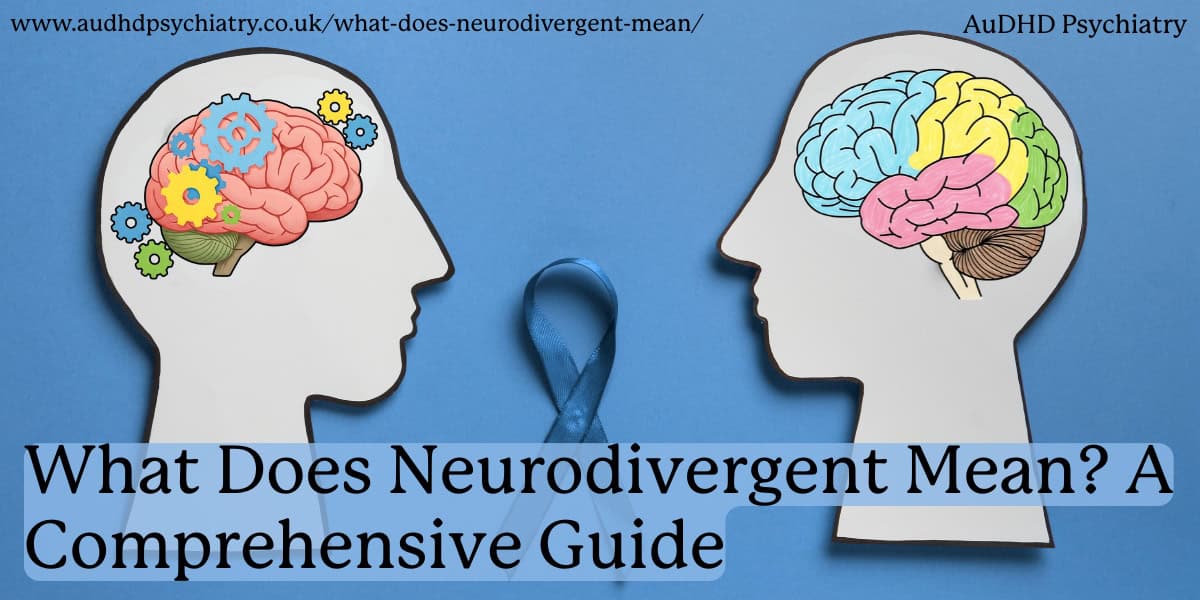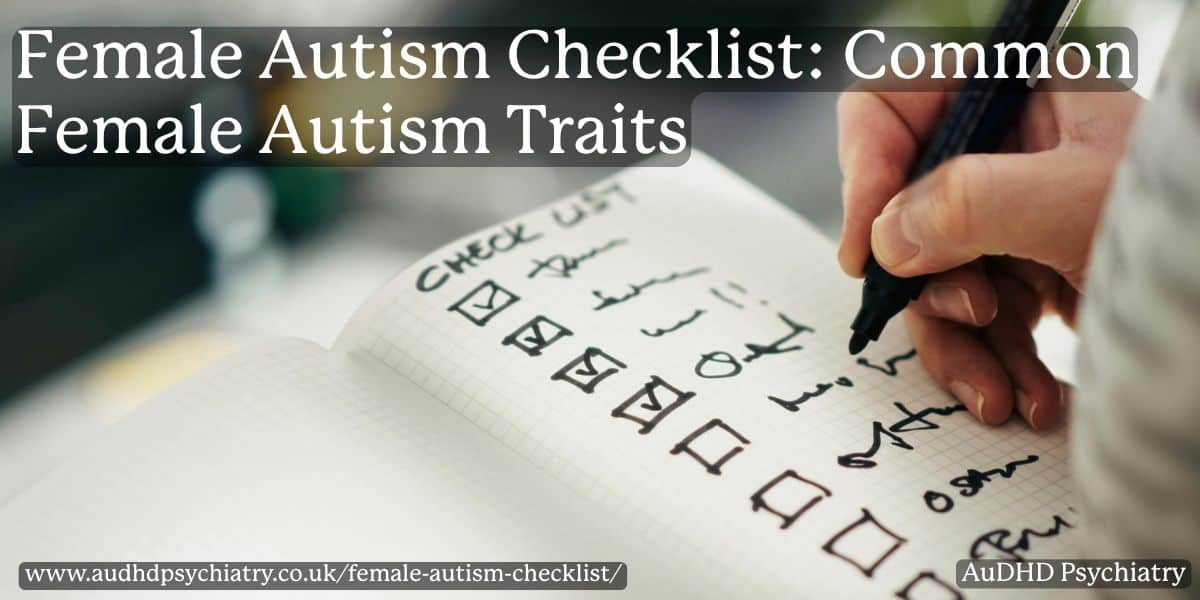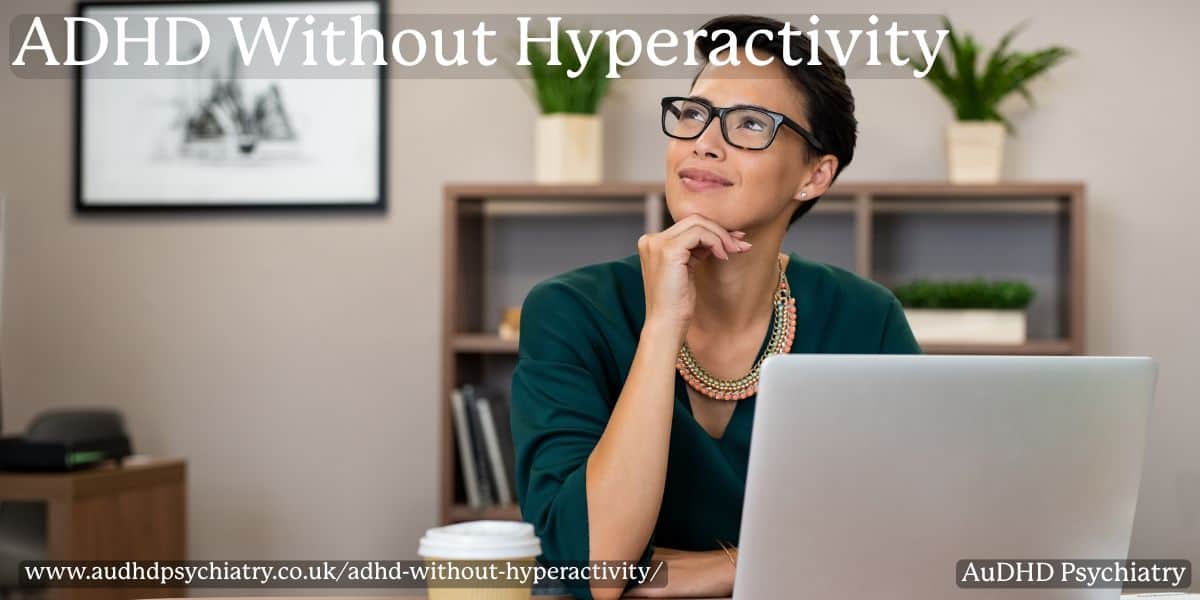
Have you ever struggled to focus, stay organised, or finish tasks—yet felt invisible because you don’t seem “hyperactive”? Living with ADHD doesn’t always mean being restless or impulsive. For many people, especially women and school-aged children, the condition presents as ADHD without hyperactivity, known clinically as inattentive ADHD.
This neurodevelopmental disorder primarily affects concentration, organisation, and sustained mental effort rather than outward hyperactivity. Unlike the more visible “hyperactive-impulsive” type, the predominantly inattentive presentation of ADHD often appears quiet, introspective, or simply “spaced out.” Understanding this form of ADHD is essential because it’s frequently misunderstood or missed entirely. People with inattentive ADHD may seem calm but often struggle internally with forgetfulness, zoning out, or mental fatigue from constant focus effort.
Recognising the signs early, whether in school-aged children, working adults, or women balancing multiple roles, can improve diagnosis and treatment outcomes. By the end of this guide, you’ll understand what ADHD without hyperactivity looks like, how it affects daily life, and what evidence-based treatments can help.
If this sounds familiar, you don’t have to keep guessing. Contact us and take the first step toward clarity, confidence, and tailored support.
What Is ADHD Without Hyperactivity?
ADHD without hyperactivity, also known as inattentive ADHD, is a form of Attention Deficit Hyperactivity Disorder (ADHD) that primarily affects focus and concentration rather than impulsive or restless behaviour. Clinically, it’s referred to as the predominantly inattentive presentation of ADHD (ADHD-PI) under the Diagnostic and Statistical Manual of Mental Disorders (DSM-5).
This form of ADHD was once known as Attention Deficit Disorder (ADD) before the American Psychiatric Association revised the terminology in the 1990s. While the word “hyperactivity” is part of the broader diagnosis, not every person with ADHD experiences hyperactive or impulsive symptoms. For those with inattentive ADHD, the challenges are mostly internal. These may look like difficulty sustaining attention, following through on tasks, and staying mentally organised.
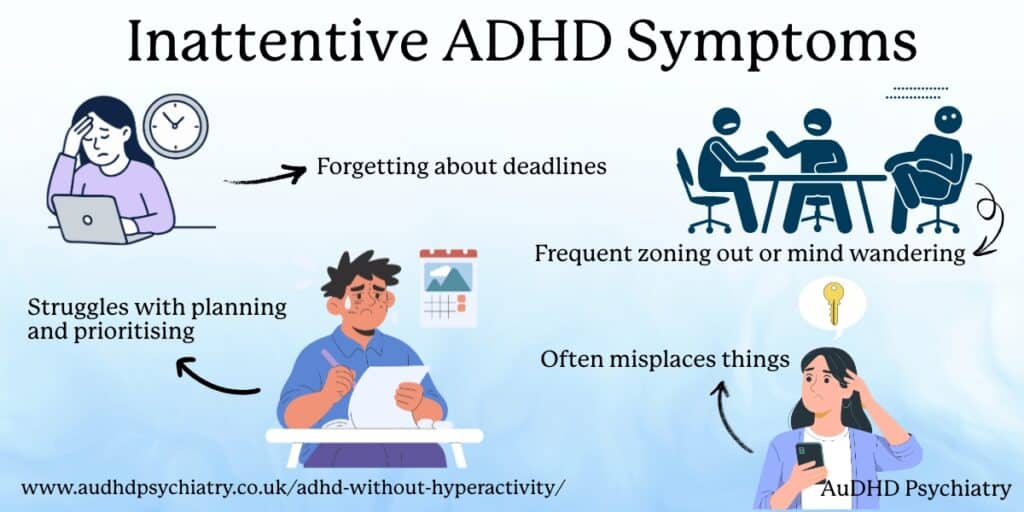
Key Characteristics of Inattentive ADHD
People with inattentive ADHD often experience:
- A short attention span and frequent mental drifting (“zoning out”).
- Trouble following conversations or detailed instructions.
- Forgetting appointments, deadlines, or daily routines.
- Struggles with executive functioning, including planning and prioritising.
- A tendency to lose or misplace things, even when trying to stay organised.
Unlike the hyperactive-impulsive type, individuals with inattentive ADHD rarely exhibit disruptive behaviours such as fidgeting or constant movement. Instead, they may appear quiet, absent-minded, or unmotivated. These traits often lead to misinterpretations that can delay recognition and support.
Why Terminology Matters
Understanding the shift from ADD to ADHD is more than semantics. It reflects the medical community’s evolving understanding that ADHD represents a spectrum of presentations, not a one-size-fits-all diagnosis. Today, clinicians categorise ADHD into three main types:
- Predominantly Inattentive Presentation (ADHD-PI)
- Predominantly Hyperactive-Impulsive Presentation
- Combined Presentation, which includes traits of both.
Each type is recognised as part of the same neurodevelopmental disorder, varying only in how symptoms appear and affect daily life. Recognising inattentive ADHD ensures that people who struggle quietly aren’t overlooked. Whether it’s a child who daydreams in class or an adult battling focus fatigue, this form of ADHD is just as valid, and just as worthy of understanding and support.
For more on how these types compare, read ADD vs ADHD, which explores diagnostic evolution and differences in symptom expression.
How ADHD Without Hyperactivity Appears in Daily Life
For many people, ADHD without hyperactivity doesn’t look like the stereotype of distraction or restlessness. Instead, symptoms emerge subtly in the background of daily life, often dismissed as personality quirks, burnout, or poor time management.
Everyday Patterns in Children and Adults
In young children, inattentive ADHD often shows up as:
- Daydreaming or “zoning out” during lessons.
- Making careless mistakes on schoolwork.
- Losing focus quickly during activities.
- Forgetting instructions or misplacing items.
For adults, the signs evolve into more complex challenges, such as struggling to finish tasks, manage deadlines, or maintain attention during meetings. Many adults describe an ongoing sense of mental fatigue and frustration, as if their minds are constantly switching tabs they can’t close.
ADHD also affects emotional regulation, making it harder to stay calm under stress or manage overwhelm. Over time, this can lead to feelings of inadequacy and low self-esteem.
Inattentive ADHD in Women
Women are especially likely to have inattentive ADHD go unnoticed. Many mask their symptoms by overcompensating. They may do so by working late, keeping detailed planners, or over-preparing to meet expectations. The result is chronic exhaustion and self-criticism.
This internal struggle is often misinterpreted as anxiety or depression rather than ADHD. Because hyperactivity isn’t visible, the cognitive load of trying to appear “together” leads to emotional burnout. Recognising how inattentive ADHD affects focus, motivation, and emotional health on a daily basis helps pave the way toward accurate diagnosis and effective management.
Why ADHD Without Hyperactivity Is Often Overlooked
Despite increased awareness, inattentive ADHD remains one of the most underdiagnosed forms of ADHD. The lack of visible hyperactivity often means symptoms go unnoticed, or are mistaken for personality differences, anxiety, or poor discipline.
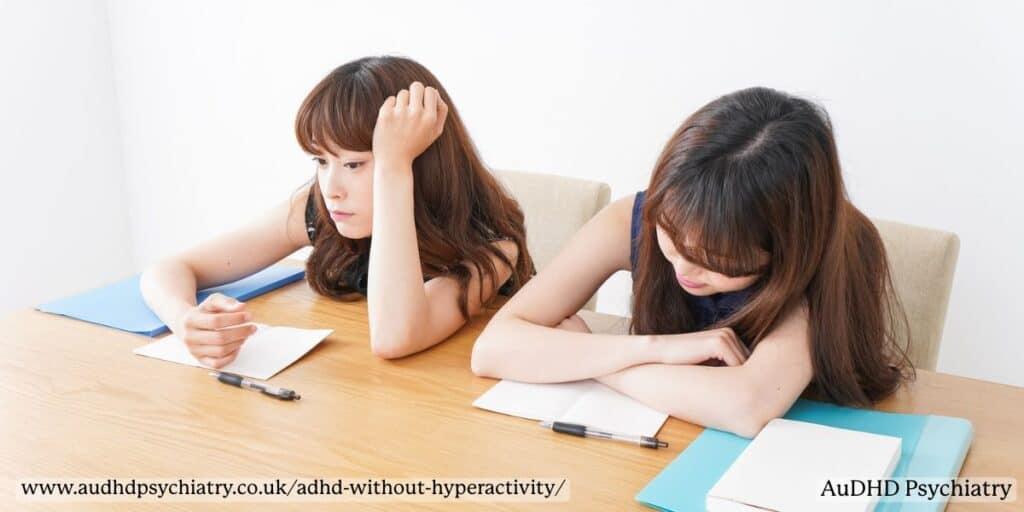
ADHD Without Hyperactivity: Gender Bias and Diagnostic Gaps
Research shows that gender differences play a major role in underdiagnosis. Diagnostic models were historically based on young boys who displayed disruptive, hyperactive behaviour. Girls and women, who are more likely to internalise symptoms, didn’t fit that pattern.
As a result, inattentive ADHD has been overlooked in educational and clinical settings, leading to decades of misdiagnosis and delayed support. Societal expectations around neatness, quietness, and emotional control further encourage masking, making early recognition harder.
Misdiagnosis and Overlapping Conditions
Because inattentive symptoms resemble those of anxiety disorders, mood disorders, bipolar disorder, and sleep disorders, women are often treated for the wrong condition. Emotional dysregulation, fatigue, and forgetfulness may also be misread as depression or burnout. You can explore similar diagnostic challenges in Adult ADHD Late Diagnosis.
Biological and Environmental Influences
While no single cause explains ADHD, factors such as brain development, hormonal fluctuations, low birth weight, and environmental factors all contribute. These biological elements can interact with social pressure and diagnostic bias, masking the disorder further. The National Institute of Mental Health and the American Academy of Paediatrics both emphasise comprehensive evaluations across different settings—home, school, or work—to ensure accurate diagnosis and personalised treatment planning.
Understanding these diagnostic barriers helps dismantle the myths that ADHD is simply a “childhood” or “male” condition. Recognising inattentive ADHD for what it is, a valid, complex neurodevelopmental condition, is the first step toward lasting change and better care.
Causes and Contributing Factors
While scientists haven’t pinpointed one exact cause of ADHD, current research confirms that it is a neurodevelopmental disorder influenced by a mix of genetic, neurological, and environmental factors.
Genetic and Brain-Based Factors
ADHD often runs in families, suggesting a strong hereditary component. Studies show that variations in genes linked to dopamine transporters and neurotransmitter regulation can impact how the brain processes focus and motivation. These small differences in brain development affect executive functions, which are skills responsible for organising, planning, and prioritising daily tasks.
Environmental and Medical Influences
Beyond genetics, environmental stressors and early medical factors can play a role. Influences such as low birth weight, prenatal exposure to toxins, or complications during pregnancy have been linked to increased ADHD risk. Similarly, external stimuli like chronic stress, poor sleep, or overstimulation can exacerbate symptoms.
Mental health conditions, including anxiety, depression, and substance use, often coexist with ADHD and may make it harder to identify the root cause of inattention. Some individuals also meet criteria for oppositional defiant disorder (ODD), further complicating diagnosis. The condition’s complex nature means ADHD isn’t caused by poor parenting, laziness, or lack of discipline. It’s a medical condition requiring proper evaluation and tailored care.
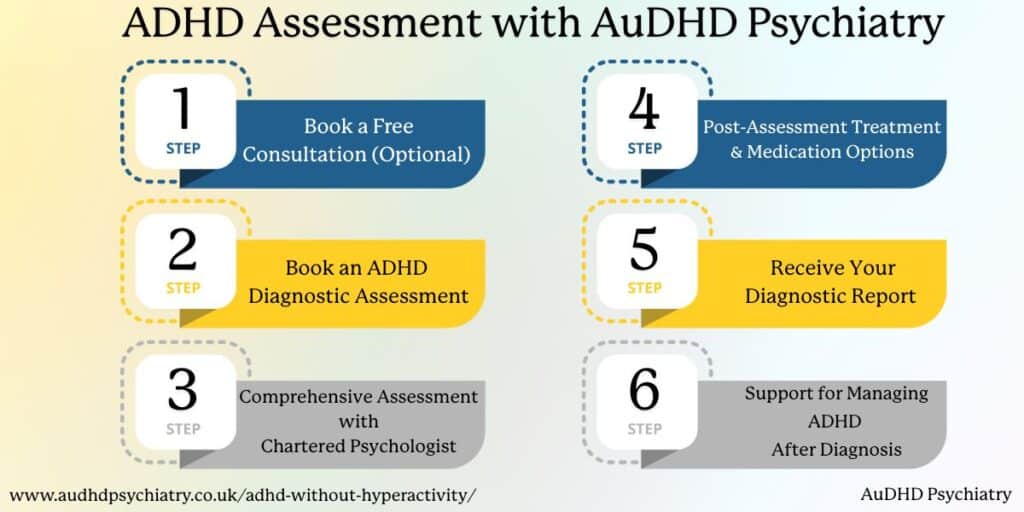
Diagnosing ADHD Without Hyperactivity
Receiving an accurate ADHD diagnosis, especially for those without overt hyperactivity, requires careful, structured evaluation. Because symptoms are often subtle, clinicians must assess behaviour patterns across different settings, such as home, work, and school. At AuDHD Psychiatry, our clinicians specialise in identifying subtler presentations of ADHD through a careful, evidence-based approach to ADHD assessment.
How Diagnosis Works
There is no single test for ADHD. Instead, our medical professionals use criteria outlined in the Diagnostic and Statistical Manual of Mental Disorders (DSM-5). This ensures that both inattentive and hyperactive-impulsive presentations are recognised under the same clinical framework.
Our comprehensive assessment combines clinical interviews, validated diagnostic tools, and behavioural observations to create a clear picture of your attention profile and daily challenges. Each stage is led by qualified medical professionals who understand how ADHD presents differently in adults, women, and children.
Step 1 – Book a Free Consultation (Optional)
Start with a no-obligation call to discuss your concerns, ask questions, and determine if an ADHD assessment is right for you. Our clinicians can guide you through what to expect and help you prepare for the diagnostic process.
Step 2 – Book an ADHD Diagnostic Assessment
If you decide to continue, you’ll schedule your full diagnostic assessment. This is where we begin gathering detailed background information about your symptoms, environment, and history to build a complete picture of how ADHD affects your daily life.
Step 3 – Comprehensive Assessment with a Chartered Psychologist
A chartered psychologist or psychiatrist conducts an in-depth interview to understand your experiences across different settings (home, work, or school). Using DSM-5 diagnostic criteria, they assess inattentive symptoms, executive functioning, and any co-occurring medical conditions.
Step 4 – Post-Assessment Treatment and Medication Options
Once your results are analysed, your healthcare provider will discuss suitable treatment options. Depending on your needs, this may include stimulant or non-stimulant medications, cognitive behavioural therapy (CBT), or ADHD coaching to support focus and emotional regulation.
Step 5 – Receive Your Diagnostic Report
You’ll receive a detailed diagnostic report outlining whether your symptoms meet the diagnosis of ADHD and what form—such as inattentive ADHD—applies to you. This report includes recommendations for work, education, and lifestyle adjustments.
Step 6 – Ongoing Support for Managing ADHD
After diagnosis, you’ll have access to ongoing support through therapy, coaching, and tailored management plans to help you apply strategies that fit your life. We also assist with accommodations and referrals for workplace or educational support, ensuring a sustainable approach to wellbeing.
Why Accurate Diagnosis Matters
Many adults, especially women, spend years feeling misunderstood before being properly assessed. Without clarity, they may develop coping patterns rooted in self-blame or overcompensation. Getting a professional diagnosis provides validation, access to treatment, and a roadmap for sustainable change.
A structured diagnosis from a healthcare provider doesn’t just name the challenge. It opens the door to treatment options, accommodations, and self-understanding that can improve daily functioning and emotional well-being. If you’re unsure whether you or someone close to you may have ADHD, book a free intro call with us. We’ll be happy to answer your questions and provide initial guidance.
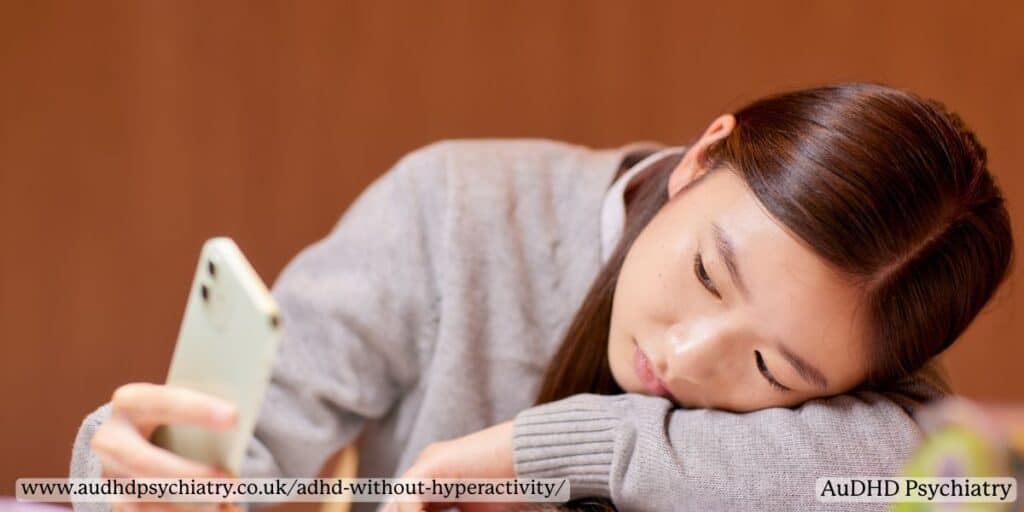
Core Symptoms and Functional Impact
People with ADHD without hyperactivity often face daily challenges that aren’t outwardly visible. Instead of restlessness or impulsive movement, the symptoms centre on inattention, forgetfulness, and mental fatigue.
Primary Symptoms of Inattentive ADHD
Common inattentive symptoms include:
- Difficulty sustaining attention during tasks or conversations.
- Making careless mistakes in work or study tasks.
- Frequently losing important items such as keys or documents.
- Avoiding tasks that require sustained mental effort.
- Appearing distracted, easily bored, or “mentally elsewhere.”
Some individuals also experience brief bursts of intense concentration, known as hyperfocus, which can make them lose track of time. While this may appear productive, it often contributes to burnout or neglect of other responsibilities.
Emotional and Social Consequences
The impact of inattentive ADHD extends far beyond organisation or productivity. Emotional regulation is often affected, leading to frustration, guilt, and low self-esteem. In social situations, this can result in missed cues, interrupted conversations, or difficulty maintaining relationships. Over time, constant self-correction can lead to chronic stress or emotional exhaustion.
Functional Difficulties in Daily Life
At work or school, people with inattentive ADHD often struggle to finish tasks or manage deadlines. They may excel during periods of novelty but lose focus once the task becomes routine. In group settings, inconsistent performance can be mistaken for laziness rather than a legitimate neurodevelopmental disorder.
Recognising these challenges is essential to building targeted coping strategies. When left unaddressed, symptoms of inattentive ADHD can disrupt careers, relationships, and overall quality of life.
Effective Treatments and Management Strategies
The good news is that inattentive ADHD is highly manageable with the right combination of treatments, therapies, and lifestyle changes. Early diagnosis and consistent care can transform daily functioning and emotional well-being.
Medication and Medical Treatment
The first line of treatment typically includes stimulant medications (such as methylphenidate or lisdexamfetamine) or non-stimulant medications, depending on a person’s response and medical history. These treatments help balance dopamine and norepinephrine—neurotransmitters linked to attention and motivation.
To learn about available options, see ADHD Medication 101: A Beginner’s Guide to Treatment Options. It’s also important to discuss side effects and dosage adjustments regularly with a qualified healthcare provider.
Therapeutic Interventions
Medication alone isn’t always enough. Cognitive behavioural therapy (CBT) and other behavioural interventions help individuals build emotional resilience and structure. Through CBT, patients learn to manage distractions, set realistic goals, and reframe unhelpful thinking patterns.
Many adults also benefit from ADHD coaching, where a professional helps them design personalised routines, manage time effectively, and create sustainable organisational systems.
Lifestyle and Daily Strategies
Beyond therapy and medication, small lifestyle changes can make a major difference:
- Prioritising consistent sleep routines and nutrition.
- Using visual planners or digital reminders to manage time.
- Incorporating short movement or mindfulness breaks.
- Breaking long tasks into smaller, achievable goals.
Family involvement and parent support are also essential for younger individuals with inattentive ADHD. When everyone understands the condition, it’s easier to build the right support network that encourages accountability and compassion. Together, these strategies form a balanced approach that supports attention, emotional regulation, and self-esteem, helping individuals thrive across both personal and professional life.
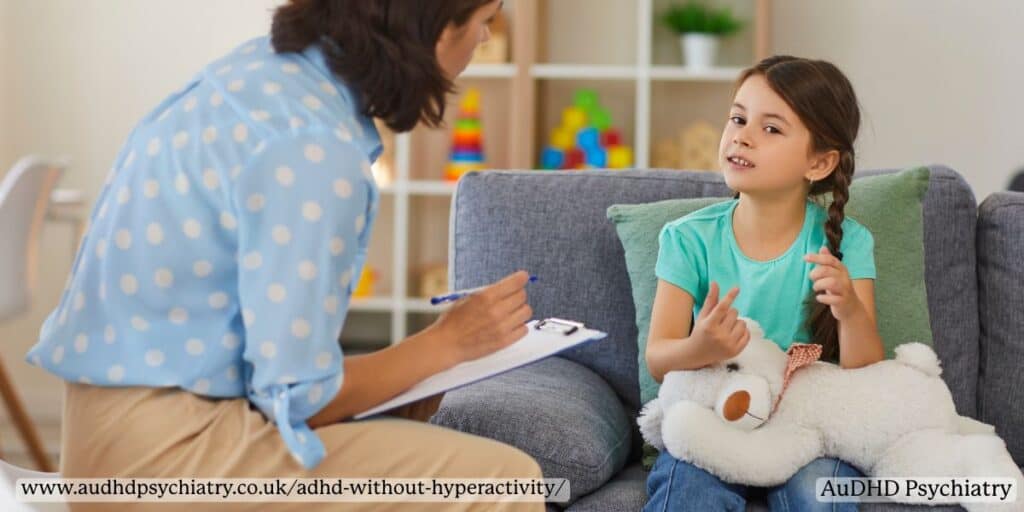
Supporting Someone With ADHD Without Hyperactivity
Living with ADHD without hyperactivity can be a daily balancing act, one that requires patience, structure, and understanding from both the individual and those around them. Because symptoms are often invisible, it’s easy for others to underestimate the impact inattentive ADHD can have on focus, memory, and emotional well-being.
Coping and Self-Management
For individuals, learning to manage daily activities starts with building predictable routines. Setting reminders, using visual planners, and breaking large tasks into smaller, time-boxed steps can reduce overwhelm. It can also help to establish “transition rituals,” such as a brief stretch or a glass of water, when switching between tasks to maintain mental momentum.
Developing strong behaviour management skills through cognitive behavioural therapy (CBT) or ADHD coaching can improve self-awareness and task follow-through. Over time, these strategies support better emotional regulation, leading to less frustration and guilt when distractions happen.
Supporting Family Members and Partners
Support from family members, friends, and partners makes a significant difference. When loved ones understand that ADHD is a neurodevelopmental disorder, not a motivation problem, communication becomes more empathetic. For parents of children with inattentive ADHD, focusing on positive reinforcement and collaborative problem-solving is more effective than punishment. Teachers and carers should aim to provide appropriate support within structured environments, especially during transitions between activities or lessons.
For partners, patience and open dialogue are key. Encouraging shared planning (for example, using shared calendars or task apps) helps avoid misunderstandings about responsibilities or forgotten details.
You can explore practical ways to access help in Access to Work ADHD Support and Resources, which outlines how workplace adjustments and coaching can benefit adults managing ADHD in professional settings.
Building Confidence and Connection
Many individuals with inattentive ADHD experience years of self-doubt before diagnosis. Joining peer support groups or engaging in therapy can help rebuild confidence, develop social skills, and provide reassurance that others face similar struggles. Compassionate support, not constant correction, fosters real progress.
Whether you’re living with inattentive ADHD or supporting someone who is, the most important thing is understanding that improvement happens gradually through structure, acceptance, and ongoing guidance.
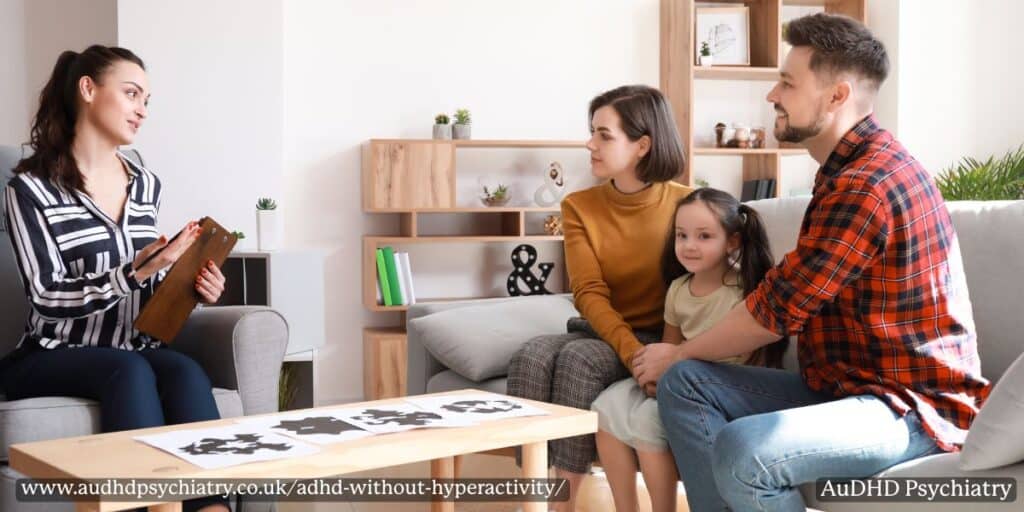
Outlook and Prevention
ADHD cannot be “cured,” but with the right support, it can be managed effectively. People with inattentive ADHD often thrive once they receive an accurate diagnosis and access to tailored treatment.
The Long-Term Outlook
With consistent behavioural interventions, medication (where suitable), and structured routines, individuals can experience major improvements in focus, emotional balance, and self-confidence. The key is early identification and collaboration with a trusted healthcare provider.
Children who receive proper support at school are less likely to develop low self-esteem or secondary mental health issues later in life. Similarly, adults who recognise their ADHD can rebuild lost confidence and develop sustainable coping systems that fit their lifestyle.
Can ADHD Be Prevented?
While there is no way to “prevent” ADHD, early recognition and appropriate support can reduce symptom severity and impact on daily functioning. Creating an environment that values flexibility, structure, and understanding helps minimise stress and builds self-efficacy.
The first step is awareness—understanding that ADHD is more than hyperactivity. Seeking an assessment when symptoms persist ensures access to professional guidance and evidence-based treatment options.
Empowerment Through Understanding
When diagnosed and supported properly, individuals with ADHD without hyperactivity often discover untapped strengths in creativity, problem-solving, empathy, and resilience. Early help empowers people to move past guilt and focus on growth.
Work closely with your healthcare provider to find the right balance of therapy (as needed), medication, and lifestyle management for your unique needs. Through consistent treatment and understanding, life with inattentive ADHD can become not just manageable, but deeply fulfilling.
ADHD Without Hyperactivity: Final Thoughts
ADHD without hyperactivity, also known as inattentive ADHD, is one of the most misunderstood presentations of attention deficit hyperactivity disorder. Its symptoms often go unnoticed, particularly in adults and women, leading to years of unnecessary struggle.
Recognising that ADHD doesn’t always look “hyperactive” is the first step toward understanding. Inattentive ADHD is not a reflection of laziness or lack of motivation. It’s a neurodevelopmental disorder that affects focus, memory, and emotional regulation. With the right combination of treatment and continuous support, individuals can experience dramatic improvements in self-esteem, productivity, and overall well-being.
If you recognise these patterns in yourself or someone you care about, professional help is available. At AuDHD Psychiatry, our clinicians provide comprehensive ADHD assessments, therapy, and coaching designed to meet your individual needs.
Your next step starts here. Book your free intro call today and take a step closer to clarity, confidence, and lasting support.
You Might Also Like
Contact Us
We’re here to answer any questions you might have.
Get in Touch
Opening Hours
Contact Form
We’re here to help. Reach out and we’ll get back to you within 24 hours (Monday – Friday).

